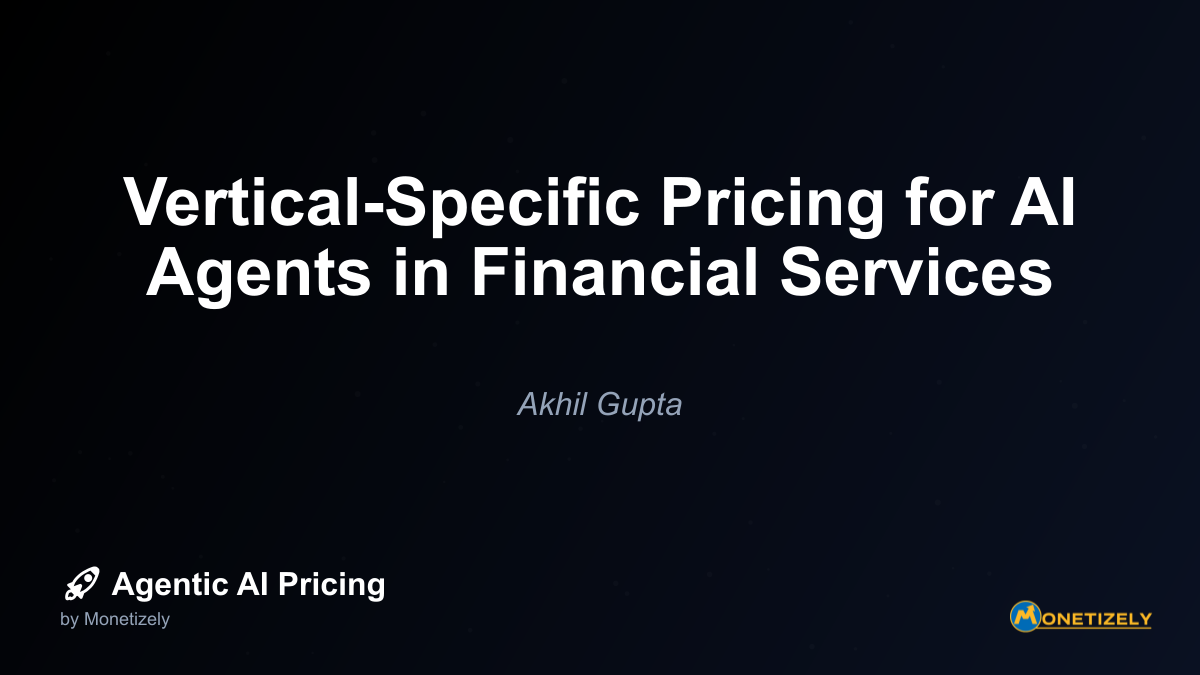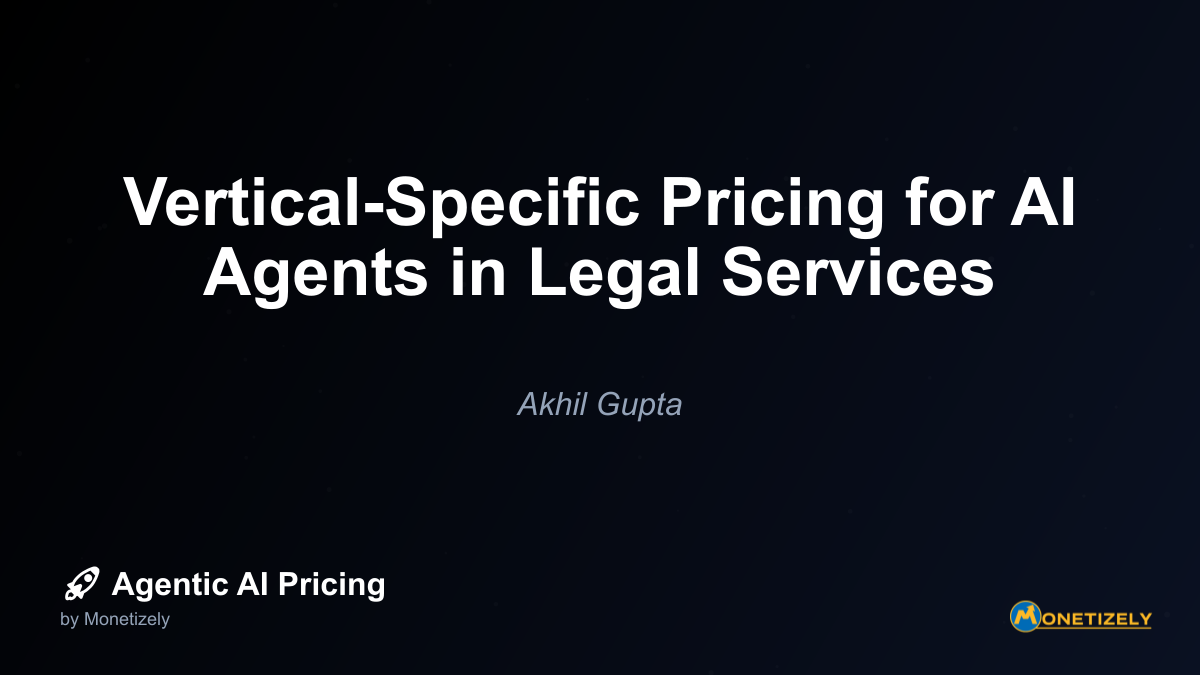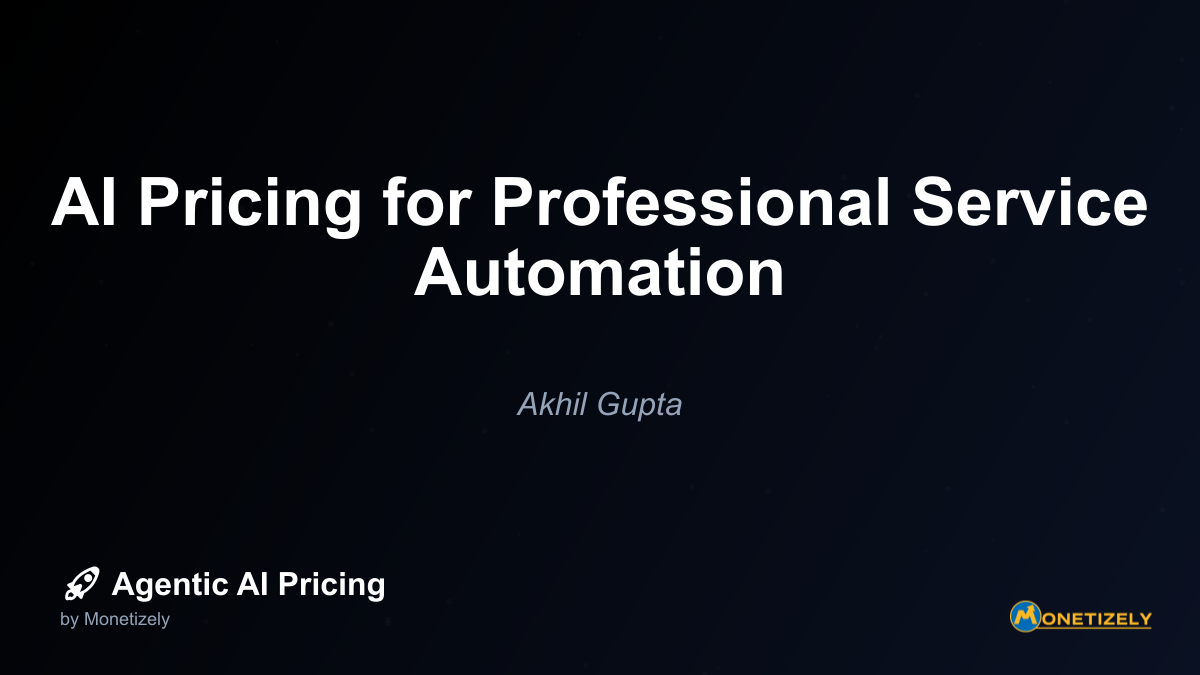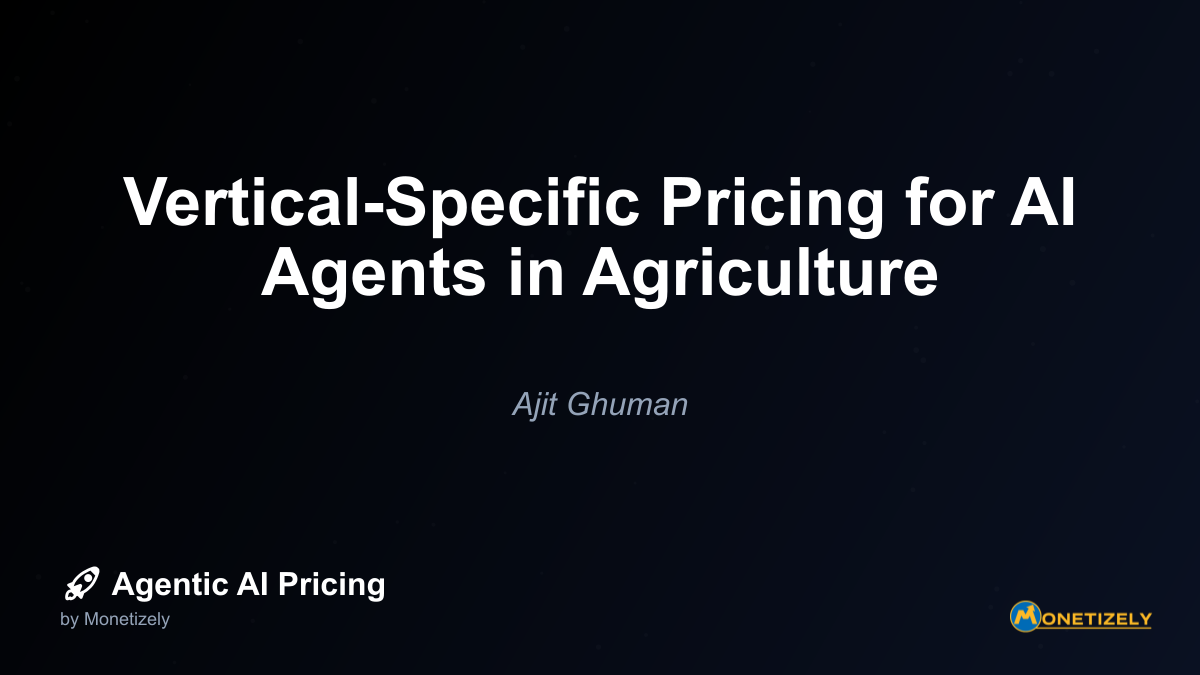· Ajit Ghuman · Industry-Specific · 11 min read
Pricing Strategy for AI in Regulated Industries
AI and SaaS Pricing Masterclass
Learn the art of strategic pricing directly from industry experts. Our comprehensive course provides frameworks and methodologies for optimizing your pricing strategy in the evolving AI landscape. Earn a professional certification that can be imported directly to your LinkedIn profile.
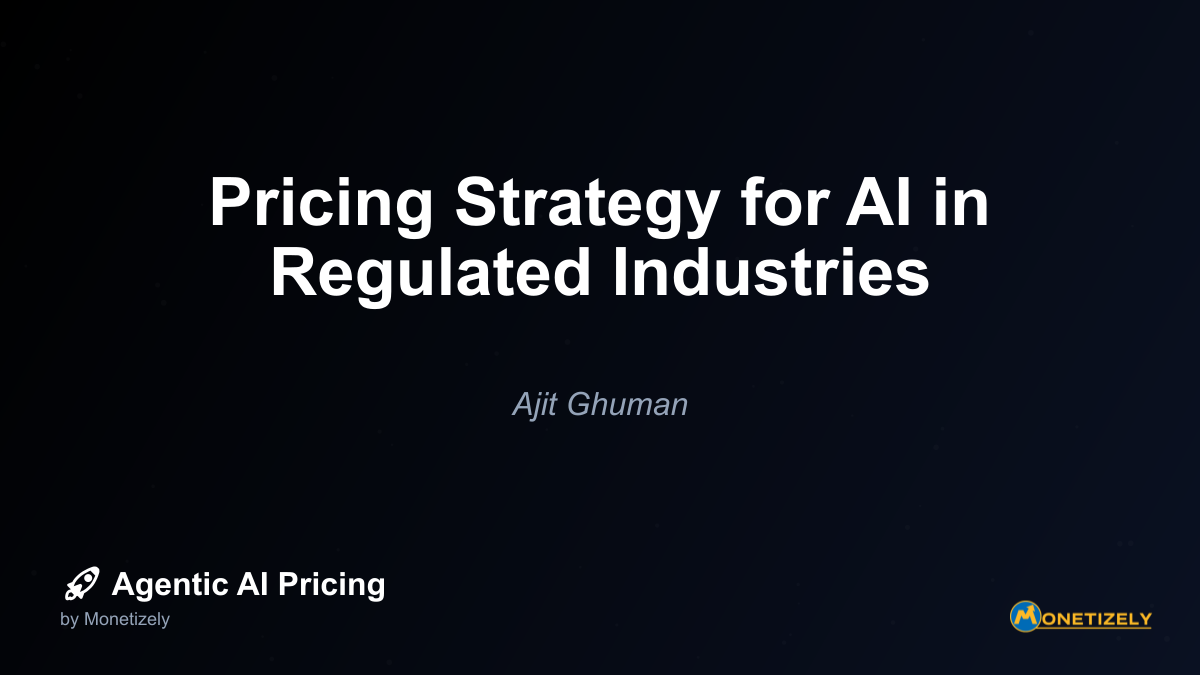
In today’s rapidly evolving landscape of artificial intelligence, developing pricing strategies for AI solutions in regulated industries presents unique challenges and opportunities. Healthcare and finance stand out as sectors where regulatory oversight, compliance requirements, and risk management significantly impact how AI products are priced and monetized. This comprehensive analysis examines the critical considerations, emerging models, and strategic approaches for pricing AI solutions in these highly regulated environments.
The Regulatory Landscape: A Complex Pricing Foundation
Regulated industries operate under strict oversight frameworks that directly impact AI pricing strategies. These frameworks create both constraints and competitive advantages for companies that can effectively navigate them.
Healthcare Regulatory Framework
In healthcare, AI solutions often fall under the FDA’s regulatory umbrella as Software as Medical Devices (SaMD). The FDA’s approach to AI/ML-based medical devices has evolved significantly, focusing on:
- Total Product Lifecycle Oversight: Continuous monitoring from development through post-market phases, requiring transparency, data quality, and structured change management
- Predetermined Change Control Plans: Allowing AI models to learn and update under predefined, FDA-approved protocols without repeated full approvals
- Transparency Requirements: Mandating audit logs and explainability, which add development and compliance costs
These regulatory requirements create significant barriers to entry but also opportunities for differentiation. As one healthcare AI executive noted, “Regulatory compliance isn’t just a cost center—it’s a competitive moat that protects established players and justifies premium pricing.”
Financial Services Regulatory Framework
The financial sector faces a more fragmented regulatory landscape with multiple overseeing bodies:
- Securities and Exchange Commission (SEC): Oversees AI used in trading algorithms and risk assessment
- Commodity Futures Trading Commission (CFTC): Regulates AI in derivatives markets
- Federal Reserve and FDIC: Monitor AI applications in banking, credit scoring, and risk management
- Consumer Financial Protection Bureau (CFPB): Focuses on fairness and nondiscrimination in consumer finance AI
These overlapping regulatory frameworks create complexity but also opportunities for specialized AI solutions that address specific compliance needs. Financial institutions are willing to pay premium prices for AI tools that demonstrably reduce regulatory risk and compliance costs.
Key Cost Components Driving AI Pricing in Regulated Industries
Understanding the cost structure is essential for developing effective pricing strategies. In regulated industries, several unique cost components influence pricing decisions:
Compliance Implementation Costs
The initial investment to ensure regulatory compliance adds approximately 5-10% to AI development budgets. These costs include:
- Certifications: HIPAA compliance in healthcare can cost between $10,000-$150,000
- Data privacy safeguards: Implementing robust data protection measures
- Auditing processes: Establishing comprehensive audit trails for regulatory review
The ongoing costs for adapting to regulatory changes typically range from 2-15% of the initial AI development cost annually, as models require retraining or system modifications to maintain compliance.
Ongoing Monitoring and Maintenance
AI systems in regulated industries require continuous monitoring to maintain compliance and effectiveness:
- Model retraining: Regular updates to maintain accuracy and compliance
- Security updates: Ongoing cybersecurity measures to protect sensitive data
- Performance tuning: Continuous optimization to ensure reliable results
These costs typically amount to 2-5% of the original development budget per year but can increase significantly when regulations change unexpectedly. In total, annual maintenance costs range from 17-30% of initial development costs.
Liability Insurance and Risk Management
Liability considerations significantly impact pricing, especially in high-stakes environments:
- Healthcare AI liability insurance: Premiums typically range from 2-8% of annual revenue depending on risk profile
- Financial services risk coverage: Increasing costs to protect against algorithmic errors or biases
- Indemnification provisions: Complex contractual arrangements to allocate risk among vendors and users
These liability costs must be factored into pricing strategies, often through risk premiums or specific contractual clauses.
Specialized Talent Requirements
Regulated industries demand expertise in both AI technology and regulatory compliance:
- Data scientists with domain expertise: Annual salaries range from $100,000 to $300,000
- Compliance analysts: Specialists who understand both AI and regulatory frameworks
- AI engineers: Technical experts who can implement compliant solutions
The competition for talent with this dual expertise drives up development costs and influences pricing decisions.
Data Management Requirements
Data handling in regulated industries involves substantial costs:
- Data acquisition and preparation: Healthcare data preparation starts at $10,000 for annotation and cleaning
- Secure storage and processing: Compliance with data protection regulations
- Integration with legacy systems: Costs range from $7,800 to $35,000 depending on complexity
These data-related expenses create a foundation for pricing strategies that must recover these investments while remaining competitive.
Emerging Pricing Models for AI in Regulated Industries
The unique challenges of regulated industries have spawned innovative pricing approaches that balance risk, compliance costs, and value creation.
Value-Based Pricing Models
Value-based pricing links payment to demonstrable outcomes, aligning vendor incentives with customer success:
- Clinical outcome-based pricing in healthcare: Payments tied to improved diagnosis rates or reduced hospital stays
- Compliance efficiency metrics in finance: Pricing based on reduced false positives in fraud detection or improved regulatory reporting
Research indicates value-based pricing can reduce overall healthcare costs by 12-18% while maintaining or improving outcomes, making it an attractive option for both vendors and customers.
Risk-Sharing Pricing Arrangements
These models distribute risk between AI providers and customers:
- Outcome guarantees: Refunds or credits if the AI solution fails to meet specified performance metrics
- Compliance warranties: Financial protection if regulatory issues arise from the AI system
- Performance bonds: Third-party guarantees for high-stakes applications
Risk-sharing creates alignment between vendors and customers while acknowledging the inherent uncertainties in AI deployment.
Tiered Compliance-Based Pricing
This approach offers different pricing levels based on regulatory burden:
- Basic tier: Non-clinical support tools with minimal regulatory requirements
- Standard tier: Tools with moderate compliance needs
- Premium tier: Diagnostic or decision-making applications requiring comprehensive compliance
This segmentation allows vendors to serve different market segments while appropriately pricing for varying levels of regulatory complexity.
Hybrid Subscription-Performance Models
Combining subscription fees with performance incentives creates balanced incentive structures:
- Base subscription: Covers core functionality and standard support
- Performance incentives: Additional payments based on achieved outcomes
- Risk pools: Financial reserves to protect against catastrophic failures
These hybrid models provide predictable revenue streams while incentivizing ongoing performance improvement.
Compliance-as-a-Service (CaaS) Integration
Increasingly, AI solutions in regulated industries incorporate compliance services directly into their offerings:
- Automated regulatory updates: Keeping systems current with changing requirements
- Audit trail generation: Creating comprehensive documentation for regulatory review
- Compliance reporting: Generating required reports for regulatory submissions
This integration allows for premium pricing by reducing customers’ compliance burden and risk exposure.
Case Studies: Successful AI Pricing in Regulated Industries
Examining real-world examples provides valuable insights into effective pricing strategies for regulated industries.
Healthcare: Viz.ai’s Tiered Value-Based Approach
Viz.ai, which developed FDA-cleared AI software for stroke detection, implemented a sophisticated pricing model that balances regulatory complexity and outcomes:
- Tiered subscription structure: Different levels based on hospital size and volume
- Performance-based rebates: Financial incentives tied to improved stroke detection rates
- Regulatory compliance package: Included services to maintain FDA compliance
This approach allowed Viz.ai to capture value proportional to outcomes while addressing the high regulatory burden of their solution.
Healthcare: Caption Health’s Value-Based Contracts
Caption Health, offering AI-assisted ultrasound guidance, implemented value-based pricing contracts with major healthcare systems:
- Direct linkage to diagnostic accuracy: Pricing tied to improved diagnostic capabilities
- Cost reduction sharing: Financial benefits from reduced downstream costs
- Alignment with FDA safety oversight: Pricing structure that supports ongoing compliance
This model created strong alignment between Caption Health’s revenue and the actual value delivered to healthcare providers.
Finance: Goldman Sachs’ Risk-Adjusted AI Pricing
Goldman Sachs incorporated regulatory compliance costs into its AI pricing strategy:
- Risk-adjusted pricing: Internal pricing reflecting compliance costs and auditability
- Embedded compliance costs: Regulatory expenses built into financial product pricing
- Transparency premium: Higher pricing for explainable AI models that satisfy regulatory requirements
This approach allowed Goldman Sachs to recover compliance investments while meeting stringent regulatory expectations.
Finance: Zest AI’s Compliance-Tiered Model
Specializing in AI-driven credit underwriting, Zest AI adopted pricing sensitive to regulatory scrutiny:
- Compliance-tiered pricing: Different levels based on regulatory complexity
- Ongoing monitoring services: Additional fees for continuous compliance checking
- Fair lending package: Premium pricing for tools that ensure regulatory compliance
This model successfully addressed the high compliance burden in financial services while creating sustainable revenue streams.
Strategic Pricing Framework for AI in Regulated Industries
Based on market research and successful case studies, a comprehensive framework emerges for pricing AI solutions in regulated industries:
1. Regulatory Burden Assessment
Begin by thoroughly evaluating the regulatory requirements affecting your AI solution:
- Identify applicable regulations: Determine which laws and standards apply
- Assess compliance costs: Calculate both initial and ongoing compliance expenses
- Evaluate liability exposure: Understand potential risks and insurance needs
This assessment provides the foundation for pricing decisions by quantifying regulatory costs.
2. Value Quantification
Clearly define and measure the value your AI solution delivers:
- Direct cost savings: Quantify reduced operational expenses
- Risk reduction: Calculate the value of decreased regulatory risk
- Outcome improvements: Measure enhanced performance or results
Value quantification supports premium pricing by demonstrating clear ROI to customers.
3. Risk Allocation Strategy
Determine how to distribute risk between your company and customers:
- Risk retention: Identify which risks you’ll manage internally
- Risk transfer: Determine which risks to share with customers
- Insurance coverage: Evaluate insurance options for catastrophic risks
This strategy informs contractual terms and pricing structures to appropriately compensate for risk.
4. Competitive Positioning Analysis
Understand your competitive landscape and positioning:
- Regulatory advantage assessment: Identify compliance strengths relative to competitors
- Value differentiation: Highlight unique benefits of your solution
- Price sensitivity analysis: Determine customer willingness to pay for compliance features
This analysis helps position your solution optimally within the competitive landscape.
5. Pricing Structure Design
Develop a pricing structure that balances regulatory costs, value delivery, and market expectations:
- Base pricing component: Cover core development and operational costs
- Compliance premium: Add charges for regulatory compliance features
- Value-based elements: Incorporate outcome-based pricing components
- Risk adjustment factors: Include pricing elements that reflect risk sharing
The resulting structure should be both profitable and aligned with customer expectations.
Implementation Challenges and Solutions
Implementing pricing strategies for AI in regulated industries presents several common challenges:
Challenge: Quantifying Regulatory Compliance Value
Many organizations struggle to measure the value of regulatory compliance, making it difficult to justify compliance-related pricing premiums.
Solution: Develop clear metrics for compliance value, such as:
- Reduced audit findings
- Decreased regulatory penalties
- Accelerated approval timelines
- Improved regulatory relationships
These metrics help communicate the tangible value of compliance features to customers.
Challenge: Balancing Price Transparency and Complexity
Regulated industries often require complex pricing structures that can be difficult for customers to understand.
Solution: Create tiered pricing with clear value progression:
- Transparent base pricing for core functionality
- Clearly defined compliance packages with explicit benefits
- Simple explanations of value-based components
- Educational materials explaining regulatory requirements
This approach maintains necessary complexity while improving customer understanding.
Challenge: Managing Evolving Regulatory Requirements
Changing regulations can disrupt pricing models and create unexpected costs.
Solution: Build regulatory adaptability into pricing structures:
- Regulatory change clauses in contracts
- Pricing contingencies for major regulatory shifts
- Regular compliance reviews and pricing adjustments
- Dedicated regulatory monitoring resources
These measures create flexibility to address regulatory changes without disrupting customer relationships.
Challenge: Demonstrating ROI for Compliance Investments
Customers may resist paying premiums for compliance features without clear ROI evidence.
Solution: Develop compelling ROI models specific to regulatory compliance:
- Case studies showing compliance cost savings
- Risk reduction calculations
- Peer comparison data
- Total cost of ownership analyses including regulatory factors
These tools help justify compliance-related pricing and demonstrate value to decision-makers.
Future Trends in AI Pricing for Regulated Industries
Several emerging trends will shape the future of AI pricing in regulated industries:
Shift to Hybrid Pricing Models
The industry is moving from traditional fixed or metered pricing to sophisticated hybrid models:
- Combined flat fees with risk- and value-based components: Creating balanced incentive structures
- Outcome-driven pricing tiers: Different levels based on achieved results
- Regulatory compliance packages: Specialized offerings for different regulatory environments
This evolution reflects the increased maturity of AI risk management and the strategic importance of AI solutions.
Rise of Responsible AI Operations (RAIops) Platforms
RAIops platforms are emerging as essential components of AI solutions in regulated industries:
- Continuous monitoring: Ensuring ongoing compliance and performance
- Transparency features: Supporting regulatory reporting requirements
- Auditability capabilities: Facilitating regulatory inspections and reviews
These platforms will increasingly be priced as premium services, reflecting their critical role in regulatory compliance.
Greater Customization for Industry-Specific Compliance
AI solutions are becoming more tailored to specific regulatory environments:
- Industry-specific data models: Trained on relevant compliance data
- Regulatory-specific features: Designed for particular regulatory frameworks
- Jurisdiction-specific configurations: Adapted to local regulatory requirements
This customization enables premium pricing based on regulatory expertise and reduced compliance risk.
Integration with AI Governance Frameworks
AI pricing will increasingly reflect alignment with established governance frameworks:
- NIST AI Risk Management Framework compliance: Becoming a baseline expectation
- Industry-specific governance standards: Emerging as differentiators
- Cross-border governance capabilities: Supporting global operations
Solutions that demonstrate strong governance alignment will command premium prices due to reduced regulatory risk.
Global Regulatory Considerations in Pricing
AI pricing strategies will increasingly account for varying global regulatory requirements:
- Regional pricing tiers: Different pricing for regions with varying compliance requirements
- Regulatory compliance packages: Optional add-ons for specific jurisdictions
- Global compliance guarantees: Premium offerings for multinational deployments
This approach allows vendors to capture the value of regulatory expertise while serving global markets.
Conclusion: Building a Sustainable AI Pricing Strategy for Regulated Industries
Developing effective pricing strategies for AI in regulated industries requires balancing multiple factors: regulatory compliance costs, risk management, value delivery, and competitive positioning. The most successful approaches share several key characteristics:
- Value-alignment: Pricing structures that connect costs to measurable customer outcomes
- Risk-sharing: Balanced allocation of risk between vendors and customers
- Compliance integration: Seamless incorporation of regulatory requirements
- Transparency: Clear communication about regulatory costs and benefits
- Adaptability: Flexibility to address evolving regulatory landscapes
Organizations that master these elements can develop pricing strategies that not only recover the substantial costs of operating in regulated environments but also create sustainable competitive advantages.
As AI continues to transform regulated industries, pricing strategies will evolve to reflect the changing landscape of compliance requirements, risk management approaches, and value creation opportunities. Companies that develop sophisticated, value-aligned pricing models will be best positioned to thrive in these complex but rewarding markets.
By thoughtfully addressing the unique challenges of regulated industries, AI solution providers can create pricing strategies that balance profitability with compliance, innovation with risk management, and value capture with customer success. This balanced approach is the foundation for sustainable growth in the rapidly evolving world of AI for regulated industries.
Co-Founder & CEO
Ajit is the author of Price To Scale, a top book on SaaS Pricing and is the Founder of Monetizely. Ajit has led and worked in pricing and product marketing at firms like Twilio, Narvar and Medallia. His work has been featured in Forbes and VentureBeat. Ajit regularly consults with software companies from Seed stage to post-IPO on pricing strategy. Ajit is also a highly-rated co-instructor for 'The Art of SaaS Pricing and Monetization' on Maven.
Pricing Strategy Audit
Let our experts analyze your current pricing strategy and identify opportunities for improvement. Our data-driven assessment will help you unlock untapped revenue potential and optimize your AI pricing approach.

